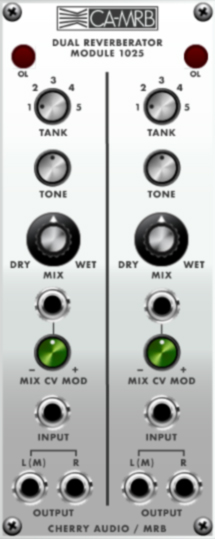
The 1025 Dual Reverberator contains two independent classic spring-type reverbs. Though ARP planned a spring reverb module, it was never actually produced - this is our take on what it might have been.
Inputs, Outputs, and Controls
Tank- Choose from five different tank choices, each with its own unique tonal and decay characteristics.
Tone- Adds or removes reverb signal brightness by turning left or right from center position. Tone has no effect on dry signals.
Wet/Dry Mix- Balances dry vs. wet signal, with center position corresponding to equal mix.
Mix CV Mod- Allows CV modulation of the Wet/Dry Mix control. The attenuator knob is bipolar; it allow positive (turn right) or inverted voltage control (turn left).
Input jack- Mono audio signal input.
L(M)/R Output jacks- Audio output dry and reverb signal mix. Use the L/M jack for mono applications. The output of the L/M and R jacks are slightly different for effective stereoization of mono signal sources.
Secret "Super Stereo" : The two reverb sections are actually slightly different and as a result can be used for a sort of "super stereo" mode. Even though each section has a stereo output, better stereo can be had by separately patching stereo inputs to the left and right sections, selecting identical tanks, and taking the stereo outputs from each L(M) Output jack.